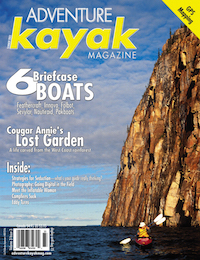Amidst Canada’s vast wilderness playground of trees, rocks and water, it seems incredible that our cozy, marshmallow-roasting campfires could have an impact. Unfortunately, campfires are among the most damaging practices in the ecosystems we escape to when we go camping. Fires deplete topsoil nutrients, scar the ground, pollute the air and introduce a risk of forest fires.
Campfires have a significant impact because there is very little topsoil on the scenic rocky coastlines of popular paddling areas such as Ontario’s Georgian Bay Islands. What little soil there is comes primarily from the decomposing wood of fallen trees, branches and leaves. The removal of deadwood for fires removes the nutrients available for plants.
Fires have also left scars on the rocks of many beautiful campsites. When I was a graduate student in archaeology, I learned that the signs of fire—be they carbon deposits on rocks, layers of ash in the soil or rock heat fractures—are among the longest-lasting markers on a campsite, remaining visible for thousands of years.
Sand will also hold a fire trail for future campers to find. Sand will melt or scar, and on popular beaches the sand is full of unburnt and partially burnt wood. Unless the fire is below the high-tide line, turning the sand under only hides the fire pit until someone tries to build a sandcastle there.
Fires also emit a lot of particulate matter. The air pollution from campfires mimics the smog of city air that so many of us are trying to escape when we head out on a kayak tour.
The risk of forest fires is almost too obvious to mention, but still a very important reason to forego the evening blaze. I recall paddling along a wilderness shoreline and smelling smoke—not directly from a camper’s fire, but pouring from the ground 50 metres away from an old fire pit. The fire had travelled through the tree roots below the fire pit. The firefighters who eventually subdued this blaze said such root fires were all too common.
Combine the potential impacts of fire with the increase in the number of people camping in an ever-shrinking wilderness and the results are obvious. In many parts of the world, fires have been banned due to limited wood supplies and heavy recre- ational use. In Canada, we are fortunate to be self-regulated with the exception of fire bans during extremely dry weather. To continue enjoying this freedom we must minimize or eliminate our fire use.
Doing without fires is simple. For cooking, camp stoves are easy to use, reasonably inexpensive and far easier to control than a campfire. Plus, your pots stay nice and shiny.
Once you get used to camping without fire, you’ll wonder why you ever bothered to spend hours of your precious vacation collecting deadwood. You’ll use that time for swimming or just relaxing. You’ll see the stars much more clearly and enjoy north- ern lights, sunsets and the serene change from dusk to dark. And when looking back at a campsite you’ve left, you’ll feel good to see no evidence, not even a fire ring or scar on the rock, to mark your stay. The next camper can enjoy the pleasure of feeling like they’ve discovered the place for the first time.
But if you must…
- Use an existing fire pit if available.
- Build beach fires in sand or gravel below the high-water mark.
- Better yet, use a fire pan that you carry with you—essentially a piece of sheet metal with the edges turned up to contain the ashes. Place the pan over a bed of sand about 5 cm thick on top of solid rock, or perch it on top of smaller rocks.
- Always keep your fires as small as possible—20 cm across for cooking.
- Use small pieces of wood and use only dead, fallen wood.
- Burn your fire completely so you have minimal ash and charcoal left over.
Jonathon Reynolds is co-author of Kayaking Georgian Bay and The Soft Paddling Guide. He and partner Heather Smith own and operate Nomadic Adventures.



